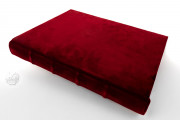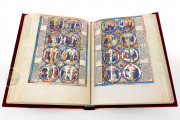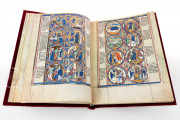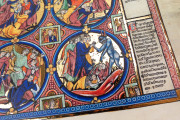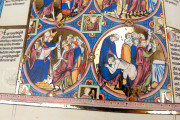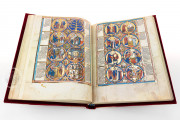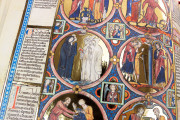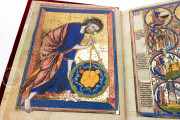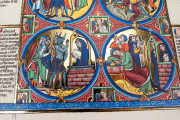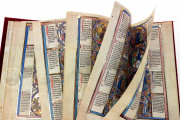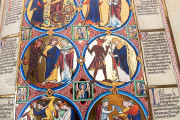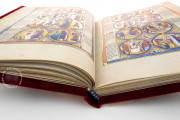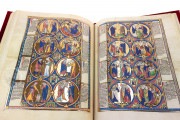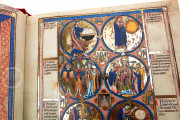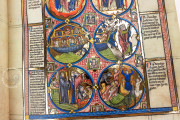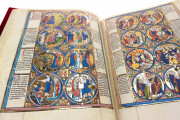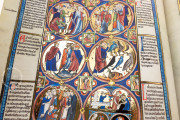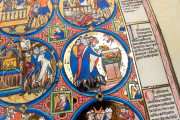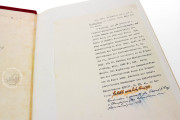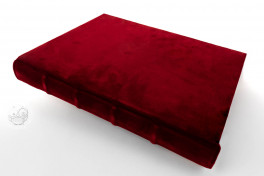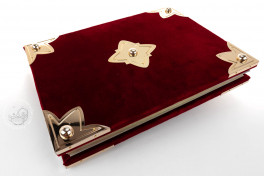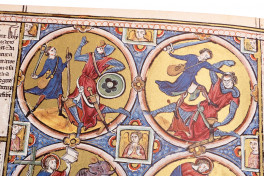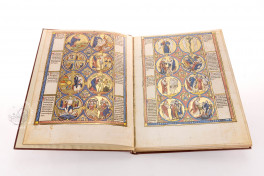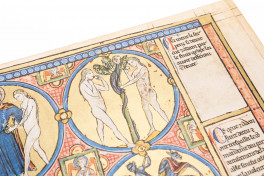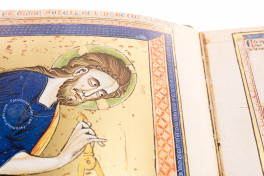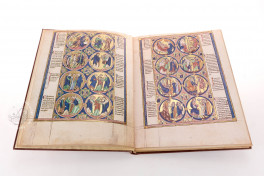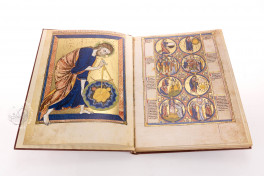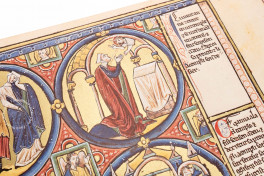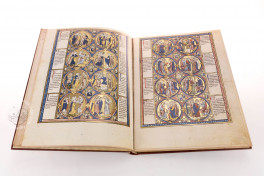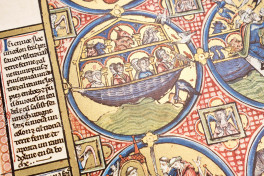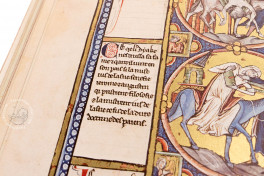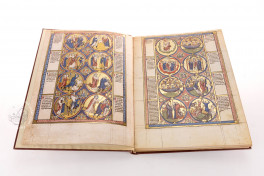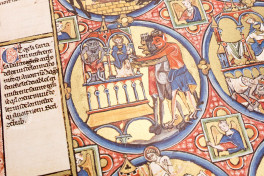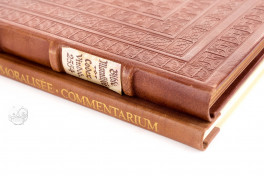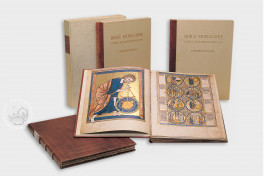Created in Paris in the 1220s, the Vienna Bible Moralisée in French is probably the earliest of four splendid manuscripts made for French royalty of a picture book that pairs episodes from the Christian Bible with illustrations of ways to understand the relationship of those biblical events to thirteenth-century European life. Called the Bible moralisée (moralized Bible), this type of book is the most ambitious visual commentary on the Bible of the Middle Ages. The 1032 painted vignettes of the Vienna manuscript are arranged eight to a page and are accompanied by explanatory captions in French. The manuscript opens with a monumental full-page depiction of God the Creator.
Although the manuscript is large and impressive in its extent, it is a fragmentary survival of a book that once had much larger pages, the generous blank margins having been trimmed away. The narrative, which begins with Genesis, ends abruptly in the book of 4 Kings, and there are substantial losses within the preserved portion.
A Supreme Achievement of Gothic Art
The manuscript was carefully planned. The leaves are painted on only one side, with an opening showing sixteen medallions alternating with a blank opening, a lavish use of the parchment. Each left-hand page shows the medallion vignettes (with their gold leaf backgrounds) against a patterned ground dominated by blue. Each facing, right-hand page, also with gold-ground medallions, has a patterned background dominated by pink. Bust-length figures occupy quatrefoils in the interstices.
Several illuminators were involved in the painting, but the underdrawings were executed by a single designer, making for a strikingly complex yet consistent decorative program. A single vision for the outcome was partly ensured by color notes in the form of letters, which are now mostly covered by the painted surface. The artist responsible for directing the work was also the author of the magnificent frontispiece.
God as Artificer
The manuscript's frontispiece is an innovative composition, showing the Creator not with dividers (a measuring instrument) but with a pair of compasses (a drawing instrument) in the act of drawing the perfect circle of the cosmos (fol. 1v). This creates a direct parallel between the Creator and the manuscript's designer, who used a compass to establish the shape of each medallion.
A Unique Arrangement
The manuscript is closely related in terms of its pictorial program to a contemporary moralized Bible (Vienna, Österreichische Nationalbibliothek, Cod. 1179) and to two later moralized Bibles, the Bible of Saint Louis and the Oxford-Paris-London Bible Moralisée (of which the Harley 1527 Bible Moralisée is the last portion). Vienna 2554 is the only one of the four arranged with the medallions and their captions designed to be read in pairs, thus: first the two at top left of the page, then the two at the top right, and then the lower pairs from left to right.
Descriptive Picture Captions
The manuscript's text is decidedly secondary to the imagery. It comprises short picture captions, eight per page, each beginning with a pen-flourished initial, alternating between red flourished with blue and blue flourished in red. Many begin with the Old French word ici ("here"), drawing the viewer's attention to what is to be seen in the adjacent image.
Hazy History
Blanche of Castile (1188-1252), Queen and consort of Louis VIII, King of France, may have commissioned the manuscript, based on presumed connections to the royal house. It was in the possession of the Mercy-Luxembourg family in the sixteenth century. After a time at the Königliches Damenstift in Hall (Tyrol), in 1783 the manuscript entered the Hofbibliothek of the Holy Roman Emperors in Vienna (eventually the Österreichische Nationalbibliothek).
We have 3 facsimiles of the manuscript "Vienna Bible Moralisée in French":
- Bibbia Moralizzata 2554 (Library Edition) facsimile edition published by Imago, 2020
- Bibbia Moralizzata 2554 facsimile edition published by Imago, 2020
- Bible Moralisée facsimile edition published by Akademische Druck- u. Verlagsanstalt (ADEVA), 1973



